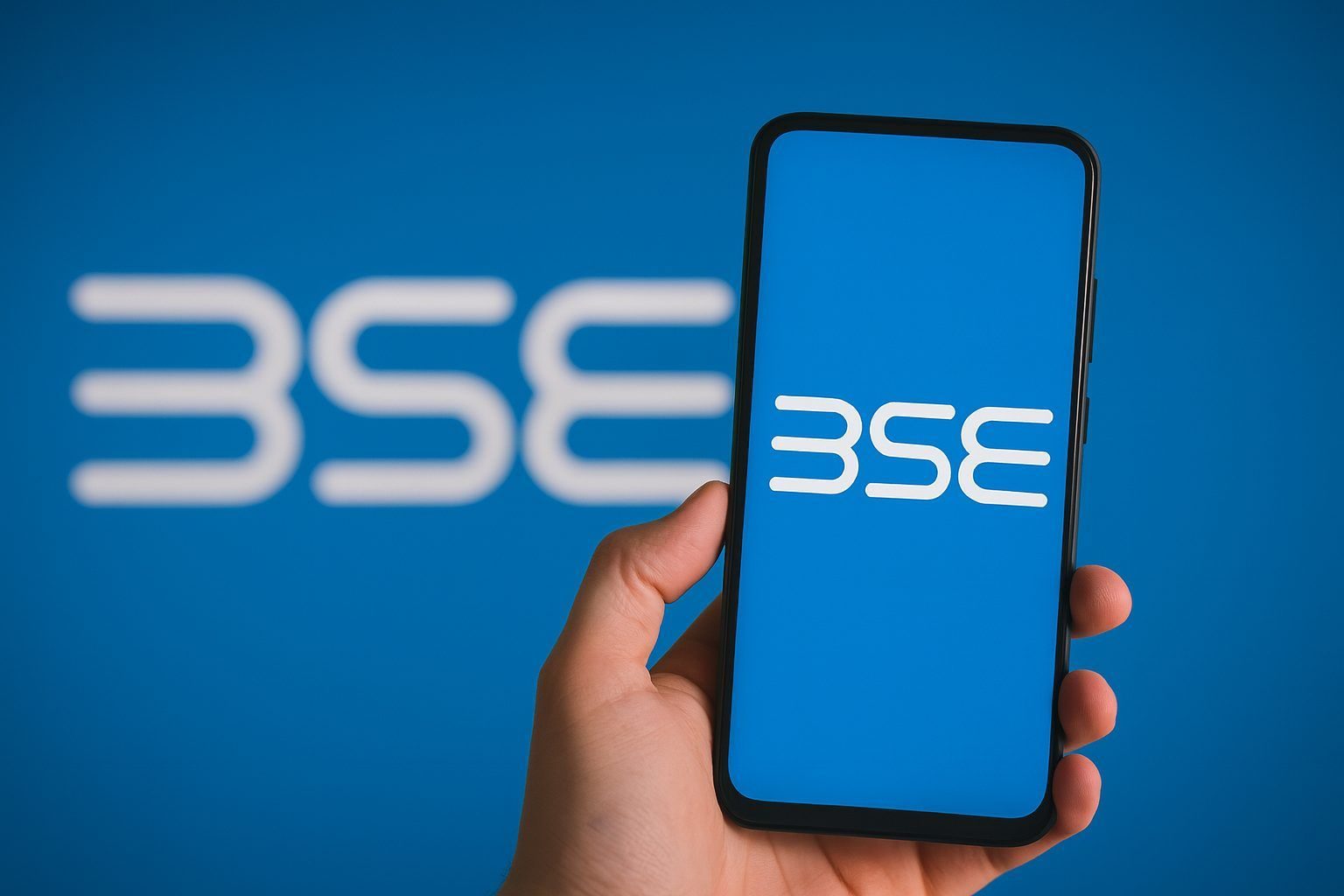Mumbai | 27 November 2025
BSE Ltd, the listed owner of Asia’s oldest stock exchange, extended its winning streak on Thursday, closing near its record high amid heavy trading volumes and a broader market that once again scaled fresh peaks.
While the benchmark Nifty 50 and BSE Sensex touched new all‑time highs on optimism around potential rate cuts and strong earnings, BSE’s own stock rode the wave of elevated derivatives and cash‑market activity that has transformed the exchange into one of the standout performers of 2025. [1]
BSE Ltd share price today: How the stock traded on 27 November 2025
On Thursday, BSE Ltd shares ended around ₹2,929–2,931 per share on the NSE, up roughly 1.5% versus Wednesday’s close of ₹2,886.70. Intraday, the stock: [2]
- Opened near ₹2,896
- Hit an intraday high in the ₹2,936 zone
- Dipped to a low just below ₹2,881
- Saw over 3 million shares change hands across exchanges, with traded value estimated in the ₹900–1,000 crore range
Key levels:
- 52‑week high: ~₹3,030
- 52‑week low: ~₹1,226–1,227
- Market capitalisation: around ₹1.18 trillion (₹1.18 lakh crore) [3]
Over the last month, BSE’s share price has climbed roughly 15–17%, from around ₹2,500 at the end of October to just under ₹2,930 today, outpacing most mid‑cap financials. [4]
A MarketsMojo review of today’s session highlights: [5]
- Strong value turnover and active market participation
- Price gains that outperformed both the broader Sensex and the capital‑markets sector index in early trade
- The stock trading just a few percent below its 52‑week high, with price action aligned above key short‑ and long‑term moving averages
In other words, BSE Ltd is not just tracking the rally — it is leading it within the capital‑markets space.
Market backdrop: Sensex and Nifty hit fresh records
Today’s move in BSE Ltd comes against a powerful macro backdrop. Indian equities are enjoying another leg of their multi‑year bull market:
- The Nifty 50 climbed to a new all‑time high around 26,307, and the BSE Sensex pushed past 86,000, surpassing peaks last seen in September 2024. [6]
- Gains are being fuelled by expectations of interest‑rate cuts from both the US Federal Reserve and the Reserve Bank of India, robust GDP growth near 7% in Q2 FY26, and a revival in corporate earnings. [7]
Indian business dailies tracked the action with live blogs that showed: [8]
- The Sensex flirting with new lifetime highs through the session
- Mid‑caps and small‑caps lagging, even as heavyweight financials and private banks supported the benchmarks
- Strong flows into sectors that benefit from lower rates and infrastructure spending
For BSE Ltd, whose revenue is tightly linked to market turnover and derivatives activity, this environment of record indices and elevated trading volumes is exactly the kind of backdrop that investors have been betting on all year.
What’s driving BSE Ltd’s rally?
1. Earnings momentum: 10th straight quarter of record revenue
Fundamentally, BSE’s latest numbers explain a big chunk of the enthusiasm. In Q2 FY26, the company delivered yet another strong quarter: [9]
- Revenue from operations: ~₹1,068 crore, up about 31–44% year‑on‑year (different data providers round it slightly differently).
- Total income: ~₹1,139 crore, marking the 10th consecutive quarter of record revenue.
- Consolidated net profit: around ₹557–559 crore, up roughly 61% YoY.
- EPS: about ₹13.7 versus ₹8.5 a year ago, reflecting significant operating leverage.
Analyst summaries attribute the surge in profits to: [10]
- Higher transaction‑linked income, particularly in index derivatives
- Strong listing and corporate‑action related fees amid a busy IPO and SME pipeline
- Continued growth from the StAR MF mutual fund distribution platform
- Tight cost control and scale benefits that have expanded EBITDA margins to the mid‑60% range (including Settlement Guarantee Fund contributions)
The takeaway: BSE is no longer just a sleepy, cash‑equity exchange; it is a scaled financial infrastructure play with multiple growing fee pools.
2. Derivatives, SME and StAR MF: the new growth engines
Recent commentary on Q2 FY26 performance shows how diversified BSE’s growth has become: [11]
- Index derivatives: Average daily premium turnover has crossed ₹15,000 crore, and management is pushing longer‑dated contracts and new products to deepen participation.
- SME platform: By October 2025, BSE’s SME segment hosted over 650 listed companies that have raised more than ₹13,000 crore cumulatively. October alone saw 27 new SME listings, signalling continued risk appetite in the primary market.
- StAR MF platform: The exchange processed about 20.1 crore mutual fund transactions in Q2 FY26, up around 24% year‑on‑year, with record monthly volumes in October.
BSE’s clearing subsidiary, Indian Clearing Corporation Ltd (ICCL), has also scaled up materially, with equity settled turnover roughly tripling and derivatives premium turnover nearly doubling in the first half of FY26, backed by tech upgrades that lifted capacity from 3,000 to 27,000 trades per second. [12]
This broad‑based operational momentum adds fundamental support to the stock’s sharp price rise.
3. Big institutional vote of confidence: LIC steps in
Another major pillar behind BSE Ltd’s re‑rating in 2025 has been aggressive institutional buying, most notably from the Life Insurance Corporation of India (LIC).
Disclosures compiled by major financial portals show that in the latest reporting cycle, LIC added BSE Ltd as a new position, purchasing about 2.28 crore shares worth roughly ₹4,637 crore. [13]
For a mid‑cap exchange operator, that is a very meaningful endorsement. Even though LIC’s moves are not a trading signal by themselves, such a large, long‑term investor stepping in tends to:
- Improve float stability
- Increase institutional ownership, often a precondition for sustained index inclusion
- Signal confidence in multi‑year earnings visibility
4. Regulatory overhang on derivatives: from headwind to “managed risk”
One of the biggest narrative swings for BSE in 2025 has been around weekly derivatives expiry rules.
Earlier this year, SEBI moved to curb speculative frenzies by standardising equity derivatives expiry to Tuesdays or Thursdays and limiting each exchange to one weekly index options contract. [14]
When it became clear that BSE would lose its advantage of multiple expiry days — and that NSE would shift its key expiries as well — BSE shares briefly tumbled. A Reuters report from June flagged concerns that a reduction in BSE’s weekly expiries could knock 10–15% off derivatives volumes and up to 6% off profitability, prompting several brokerages to cut their target prices. [15]
However, the story did not end there:
- BSE has adapted its product mix and continued to grow index‑derivatives turnover despite the new framework. [16]
- Recent regulatory discussions are focused on reviving currency derivatives volumes rather than further tightening index options, suggesting that the heaviest blows to BSE’s derivatives franchise may already be behind it. [17]
Investors now tend to treat SEBI’s expiry‑day reforms as a manageable structural risk, not an existential threat — particularly in light of the strong earnings delivery since.
How expensive is BSE Ltd stock now?
With the stock hovering near record territory, the inevitable question is: has BSE run too far, too fast?
Different data providers peg the valuation slightly differently, but the broad picture is consistent: [18]
- Market cap: ~₹1.18 lakh crore
- Trailing P/E: generally in a mid‑ to high‑double‑digit band (roughly 45–65x trailing 12‑month earnings depending on methodology)
- Price‑to‑book: comfortably above 20x, with some screeners showing the P/B ratio in the mid‑20s
- Dividend yield: modest (around 0.2–0.8%, far below most large financials)
- Debt: BSE remains almost debt‑free
Stock‑screening platforms flag BSE as: [19]
- A company with 5‑year profit CAGR above 60% and a healthy historical dividend payout ratio over 40%
- But also one that trades at a steep premium to book value, prompting automated labels like “Expensive Star” and “Expensive valuation”
Perhaps most tellingly, Trendlyne’s consensus of 14 analysts puts the 12‑month target price near ₹2,680–2,700, implying single‑digit downside from current levels. [20]
That doesn’t mean the stock must fall — targets are routinely revised in fast‑moving markets — but it does show how much good news is already priced in.
Technical picture: Momentum strong, but delivery volumes wobble
On the technical side, BSE Ltd’s chart is about as clean as bulls could hope for: [21]
- The stock is trading above its 5‑, 20‑, 50‑, 100‑ and 200‑day moving averages, a classic sign of a strong uptrend.
- It sits roughly 3–4% below its all‑time high of ₹3,030, keeping it firmly in “near 52‑week high” territory.
- Momentum scores on popular platforms categorise the stock as “moderately to strongly bullish.”
However, today’s MarketMojo update also highlights an important nuance:
- Delivery volumes (shares actually taken into demat, not just traded intraday) have recently dipped below their five‑day average, suggesting a larger share of activity is coming from short‑term traders and intraday strategies rather than long‑term accumulation. [22]
In practical terms, that means:
- The trend is strong, but
- Near‑term price action could become more volatile, as momentum traders can exit quickly if the broader market wobbles or if regulatory headlines re‑emerge.
Key numbers at a glance (27 November 2025)
Approximate consolidated snapshot from multiple market data providers: [23]
- Closing price (NSE): ~₹2,929.5
- Day’s range: ~₹2,881 – ₹2,936
- Prev. close: ₹2,886.7
- 1‑day move: +1.4–1.5%
- 1‑month move: roughly +15–17%
- 52‑week range: ~₹1,226 – ₹3,030
- Market cap: ~₹1.18 lakh crore
- Volume (today): >3 million shares
- Valuation: High double‑digit P/E; P/B well above 20x
Figures may differ marginally between data vendors because of timing (real‑time vs end‑of‑day) and methodology.
What should investors watch next?
For readers tracking BSE Ltd for the medium to long term, the key watch‑points from here are:
- Q3 FY26 results and guidance
- Can BSE maintain 30–40%+ revenue growth and 60%+ profit growth as the base gets larger, especially in derivatives and clearing? [24]
- Regulatory decisions on derivatives and currency markets
- Ongoing talks around easing currency‑derivatives restrictions and fine‑tuning expiry rules could alter the competitive balance between onshore exchanges and offshore venues, with BSE positioned as a key beneficiary if onshore volumes revive. [25]
- Sustainability of IPO and SME momentum
- A slowdown in SME or mainboard listings would eventually feed into lower listing fees and transaction revenue; conversely, a continued boom keeps BSE’s multi‑engine growth story intact. [26]
- Valuation discipline
- With the stock already discounting a lot of good news, any disappointment on earnings, regulation or market volumes could trigger a sharp de‑rating, especially if leveraged traders rush for the exit.
- Competitive dynamics with NSE
- Shifts in weekly expiry patterns, new product launches, or pricing changes can rapidly move market share between the two exchanges, directly impacting BSE’s high‑margin derivatives income.
Bottom line
On 27 November 2025, BSE Ltd is trading like a high‑beta proxy for India’s market exuberance:
- The stock is near its all‑time high
- Volumes are robust, valuations are rich
- Fundamentals — especially earnings growth and platform scale — remain very strong
For growth‑oriented investors, BSE offers a rare, pure‑play exposure to the picks‑and‑shovels side of the Indian bull market: index derivatives, SME listings, mutual fund distribution and clearing infrastructure.
For more conservative investors, the current setup may look more like “great company, demanding price” — where risk management and entry discipline matter as much as the underlying story.
Either way, BSE Ltd will likely stay front and centre on market watchlists as long as Indian indices hover at record highs and derivatives trading continues to dominate the conversation.
References
1. www.reuters.com, 2. www.investing.com, 3. www.livemint.com, 4. www.investing.com, 5. www.marketsmojo.com, 6. www.reuters.com, 7. www.reuters.com, 8. economictimes.indiatimes.com, 9. alphastreet.com, 10. alphastreet.com, 11. www.multibagg.ai, 12. www.multibagg.ai, 13. www.moneycontrol.com, 14. www.reuters.com, 15. www.reuters.com, 16. www.multibagg.ai, 17. www.reuters.com, 18. www.livemint.com, 19. trendlyne.com, 20. trendlyne.com, 21. www.marketsmojo.com, 22. www.marketsmojo.com, 23. www.investing.com, 24. alphastreet.com, 25. www.reuters.com, 26. www.multibagg.ai







